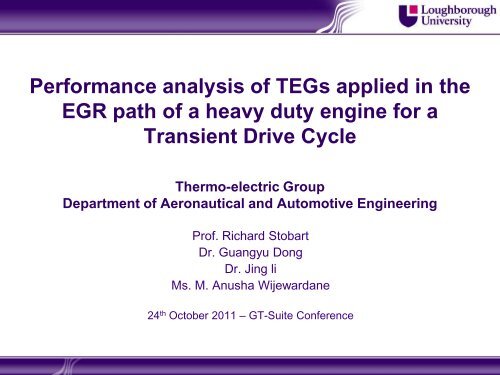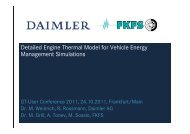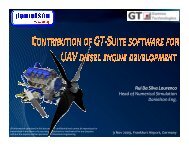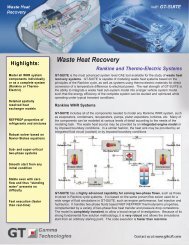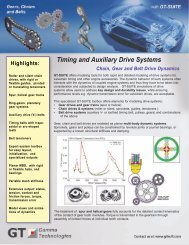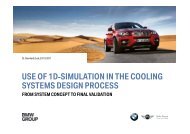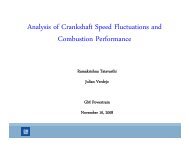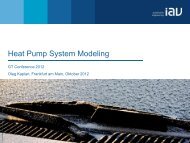Performance analysis of TEGs applied in the EGR path of a heavy ...
Performance analysis of TEGs applied in the EGR path of a heavy ...
Performance analysis of TEGs applied in the EGR path of a heavy ...
Create successful ePaper yourself
Turn your PDF publications into a flip-book with our unique Google optimized e-Paper software.
<strong>Performance</strong> <strong>analysis</strong> <strong>of</strong> <strong>TEGs</strong> <strong>applied</strong> <strong>in</strong> <strong>the</strong><strong>EGR</strong> <strong>path</strong> <strong>of</strong> a <strong>heavy</strong> duty eng<strong>in</strong>e for aTransient Drive CycleThermo-electric GroupDepartment <strong>of</strong> Aeronautical and Automotive Eng<strong>in</strong>eer<strong>in</strong>gPr<strong>of</strong>. Richard StobartDr. Guangyu DongDr. J<strong>in</strong>g liMs. M. Anusha Wijewardane24 th October 2011 – GT-Suite Conference
Outl<strong>in</strong>e• Background• Objectives• Introduction to 1-D TEG model<strong>in</strong>g equations• C6.6 eng<strong>in</strong>e and <strong>the</strong>rmo-electric generator (TEG) 1-D model• NRTC drive cycle• Results• Development <strong>of</strong> a Real-Time (RT) Simulation Tool• Conclusions• Future works2
Background• Approximate energy balance for IC eng<strong>in</strong>es at maximum power;Brake power(%)Coolant (%) Oil (%) Exhaust (%) Incompletecombustion (%)SI Eng<strong>in</strong>es 25-28 17-26 3-10 34-45 2-5CI Eng<strong>in</strong>es 34-38 16-35 2-6 22-35 1-2Guzzella L., Sciarretta A. Vehicle Propulsion Systems – Introduction to Modell<strong>in</strong>g and Optimization, ISBN-13 978-3-540-25195-8Pressure losses <strong>in</strong> exhaust after treatment system have to be considered for<strong>heavy</strong> duty diesel eng<strong>in</strong>e applications• Potential for enhancement <strong>of</strong> ICE performance us<strong>in</strong>g advanced eng<strong>in</strong>etechniques such as; downsiz<strong>in</strong>g, VVT, advance fuel <strong>in</strong>jection, advancedboost<strong>in</strong>g and etc are extremely limited• Enhanced BSFC and <strong>the</strong>rmal efficiencies can be achieved by energyrecovery from exhaust gas and coolant3
Background cntd…Average fuel economy improvementsfrom energy recovery systems;• Thermo-dynamic cycles - 6-8% 1• Turbo-mach<strong>in</strong>es - 5-7% 2• Thermo-electric - 3-5% 3<strong>TEGs</strong>;• Direct heat to electricity converters• Solid state• Durable1. Sandra, H., Stobart, R.K, Adam, C. and Peter, C. Energy Recovery Systems for Eng<strong>in</strong>es. SAE Technical Paper, 2008-01-0309,20082. Turbocharger Facts, BorgWarner Turbo Systems, Specialists <strong>in</strong> Advanced Turbocharger Technology, Switzerland, 20093. Stobart, R.K., Wijewardane, M. and Allen, C. The potential for <strong>the</strong>rmoelectric devices <strong>in</strong> passenger vehicle applications, SAETechnical Paper, 2010-01-0833, 20104
Objectives• Simplify<strong>in</strong>g a 3-D TEG model <strong>in</strong>to a 1-D TEG model• Heat recovery from <strong>the</strong> TEG and performance <strong>analysis</strong> <strong>of</strong> a<strong>heavy</strong> duty eng<strong>in</strong>e for a transient drive cycle• Development <strong>of</strong> a component-<strong>in</strong>-<strong>the</strong>-loop (CIL) tool to analyze<strong>the</strong> performance <strong>of</strong> a TEG <strong>in</strong>strumented <strong>in</strong> an eng<strong>in</strong>e <strong>in</strong> real-time5
Introduction to 1-D TEG model<strong>in</strong>g equations• Voltage across <strong>the</strong> external load;V total = VSeebeck- Vresist;VSeebeck= αnp(TH- TL);Vresist=• Power generated by a TE-couple;P total = IVtotal• Heat rate at source;QH• Heat rate at s<strong>in</strong>k;6=αITH+KA(TH− TQ H = αITL+ KA(TH− TL)+Non-dimensionalThermoelectricFigure <strong>of</strong> meritZL) − 0.5I=0.5I2α npσK22RRLLConversionefficiencyϕ =( ) ( + − )T − T 1 ZTavg1hIRTh<strong>in</strong>tc⎛⎜⎝TE Couple1+ZTavg+TTch⎞⎟⎠
Thermo-electric generator (TEG) 3-D model• 3-D model<strong>in</strong>g <strong>of</strong> <strong>the</strong> TEGwas performed us<strong>in</strong>g Star-CCM+ 6.02.009• TEM properties weredef<strong>in</strong>ed with respect toHeat flow across <strong>the</strong> TEG heat exchangercommercially available Hi-ZTEMs• 1-D GT-Power model wasdeveloped and validatedbased on <strong>the</strong> resultsobta<strong>in</strong>ed by <strong>the</strong> 3-D steadystate model7TEG used for 3-D model<strong>in</strong>g
Thermo-electric generator (TEG) 1-D model cntd... Eng<strong>in</strong>e ModelA Caterpillar medium-duty <strong>of</strong>fhighwayeng<strong>in</strong>e is used buildand validate <strong>of</strong> a 1-D eng<strong>in</strong>emodel.Eng<strong>in</strong>e modified forexperimental purposes with:‣ high pressure loop <strong>EGR</strong>system‣ variable geometry turb<strong>in</strong>eCaterpillar diesel eng<strong>in</strong>e test bench(VGT)8
Thermo-electric generator (TEG) 1-D model cntd... Eng<strong>in</strong>e ModelConfiguration parameters are all measured from <strong>the</strong> real eng<strong>in</strong>e or from <strong>the</strong> eng<strong>in</strong>edatasheet.91-D Eng<strong>in</strong>e model <strong>in</strong> GT-power
Thermo-electric generator (TEG) 1-D model cntd...1-D TEG model TE material characteristicsTotal SeebeckCoefficient (μV / K) 375Internal ElectricResistance (Ohm) 0.15Thermal Conductivity <strong>of</strong>TE material (W/mK) 2.40Thermoelectric MaterialCross Sectional Area(mm^2) 4225Thermoelectric MaterialHeight (mm) 4‣ 1-D TEG model is positioned <strong>in</strong> <strong>the</strong> <strong>EGR</strong> <strong>path</strong>‣ Energy recovery <strong>of</strong> <strong>the</strong> TEG was obta<strong>in</strong>ed for <strong>the</strong> NRTC cycle10
NRTC drive cycle: Analysis <strong>of</strong> <strong>the</strong> operation condition <strong>of</strong> <strong>EGR</strong> <strong>path</strong>800NRTC Cycle run <strong>of</strong> C6.6 Diesel Eng<strong>in</strong>e700600Torque (N.m)50040030020010000 500 1000 1500 2000 2500Speed (r/m<strong>in</strong>)Operation po<strong>in</strong>ts under NRTC cycleNRTC is a transient driv<strong>in</strong>g cycle‣ Developed by <strong>the</strong> US EPA <strong>in</strong> cooperation with <strong>the</strong> EU authorities‣ For mobile non-road diesel eng<strong>in</strong>es‣ Used for emission certification/type approval <strong>of</strong> non-road eng<strong>in</strong>es11
NRTC drive cycle: Mass flow and Temperature Distribution<strong>EGR</strong> gas temperature w<strong>in</strong>dowTorque (N.m)8007006005004003002001000NRTC Cycle run <strong>of</strong> C6.6 Diesel Eng<strong>in</strong>eW<strong>in</strong>dow <strong>of</strong> operat<strong>in</strong>g po<strong>in</strong>ts0 500 1000 1500 2000 2500Speed (r/m<strong>in</strong>)Exhaust Temperature (K)<strong>EGR</strong> gas mass flow (g/s)8508007507006506005505004504007060504030201000 100 200 300 400 500 600Torque (N.m)Mass flow w<strong>in</strong>dow0 100 200 300 400 500 600Torque (N.m)Zone 1Zone 2Zone 3Zone 1Zone 2Zone 3• An approximately l<strong>in</strong>ear relationship between <strong>the</strong> <strong>EGR</strong> temperature and eng<strong>in</strong>e load.• The figure <strong>of</strong> <strong>EGR</strong> mass flow rate shows that <strong>the</strong> range is ma<strong>in</strong>ly with<strong>in</strong> <strong>the</strong> range <strong>of</strong>10-40 g/s.12
NRTC drive cycle: Transient <strong>Performance</strong> Analysis <strong>of</strong> <strong>the</strong> eng<strong>in</strong>eTemperature and mass flow under NRTC cycle• The control algorithm <strong>of</strong> <strong>the</strong> eng<strong>in</strong>e was constructed based on <strong>the</strong> look-up tables <strong>in</strong><strong>the</strong> test eng<strong>in</strong>e ECU• "Automatic Shut-Off When Steady-State" was <strong>of</strong>f for <strong>the</strong> dynamic characteristics and<strong>the</strong> transient behaviour simulation13
Results: Availability and Power Generation• The availability represents <strong>the</strong> maximum amount <strong>of</strong> energy that can be recoveredfrom <strong>the</strong> <strong>EGR</strong> flow• Dur<strong>in</strong>g <strong>the</strong> NRTC, <strong>the</strong> maximum power is about 170 W and average <strong>of</strong> 60W isachieved, but will decrease dramatically when <strong>the</strong> <strong>EGR</strong> valve gett<strong>in</strong>g closed• 8TEM-TEG <strong>in</strong>stalled <strong>in</strong> <strong>the</strong> <strong>EGR</strong> <strong>path</strong> is able to save, 0.06% <strong>of</strong> total fuel requirementper drive cycle14
Results: TEG <strong>in</strong>duced pressure loss54Pressure drop (kPa)321• The maximum pressure drop caused by current TEG system is about 4 kPa, this isless than 10% <strong>of</strong> <strong>the</strong> pressure drop <strong>in</strong> <strong>the</strong> <strong>EGR</strong> <strong>path</strong>.• This <strong>in</strong>dicates that <strong>the</strong> <strong>EGR</strong> amount will be only be slightly affected by <strong>the</strong> currentTEG system.1500 200 400 600 800 1000 1200Time (s)Back pressure developed by <strong>the</strong> TEG over <strong>the</strong> NRTC cycle
Development <strong>of</strong> Real-Time Simulation ToolComponent <strong>in</strong> <strong>the</strong> loop simulation through GT-Power with NI VeriStandNI VeriStand is a s<strong>of</strong>tware environment for real-time test<strong>in</strong>g applications.• Helps configure a multicore-ready real-time eng<strong>in</strong>e to execute• Run <strong>the</strong> TEG model <strong>in</strong> real time and predict <strong>the</strong> energy recovery process.• Reduce <strong>the</strong> experimental cost and accelerate <strong>the</strong> TEG system optimization.16
Development <strong>of</strong> Real-Time Simulation Tool• Create TEG 1-D model<strong>in</strong> GT-Power• Generate <strong>the</strong> Real Time(RT) .dat file andconvert to executablecode through Veristand• Add <strong>the</strong> virtual TEG <strong>in</strong><strong>the</strong> CIL system• Real time simulation forTEG systemperformance <strong>analysis</strong>Diagram <strong>of</strong> CIL experiment17
Conclusions (1)Based on a 1 dimensional eng<strong>in</strong>e model and TEG model built up<strong>in</strong> GT-power environment, <strong>the</strong> operat<strong>in</strong>g condition <strong>of</strong> <strong>EGR</strong> <strong>path</strong>under <strong>the</strong> NRTC cycle was analysed:‣ The <strong>EGR</strong> temperature and mass flow rate were estimated‣ There is almost a l<strong>in</strong>ear relationship between <strong>the</strong> <strong>EGR</strong>temperature and eng<strong>in</strong>e load.‣ The range <strong>of</strong> <strong>EGR</strong> mass flow rate is ma<strong>in</strong>ly with<strong>in</strong> <strong>the</strong> range<strong>of</strong> 10-40 g/s.‣ The variation <strong>of</strong> temperature, mass flow and energyavailability under NRTC cycle was simulated.18
Conclusions (2)‣ Us<strong>in</strong>g <strong>the</strong> control parameters <strong>in</strong> <strong>the</strong> test eng<strong>in</strong>e ECU as <strong>the</strong>reference, a control algorithm was developed to run <strong>the</strong> GTpowermodel <strong>in</strong> transient mode.‣ The power regeneration can be calculated accord<strong>in</strong>gly. Themaximum power is about 170 W, and it will decreases nearlyto zero when <strong>the</strong> <strong>EGR</strong> valve is closed.‣ The pressure drop caused by current TEG system is about 4kPa, less than 10% <strong>of</strong> <strong>the</strong> total pressure drop <strong>in</strong> <strong>EGR</strong> <strong>path</strong>.19
Future Works‣ Component <strong>in</strong> <strong>the</strong> loop simulation through GT-power coupl<strong>in</strong>gwith NI Veristand has great potential for <strong>the</strong> <strong>analysis</strong> <strong>of</strong> TEGperformance‣ Permits parametric studies <strong>of</strong> TEG system‣ Allows fast optimization cycles us<strong>in</strong>g physical models <strong>of</strong> TEG20
Thank you !


